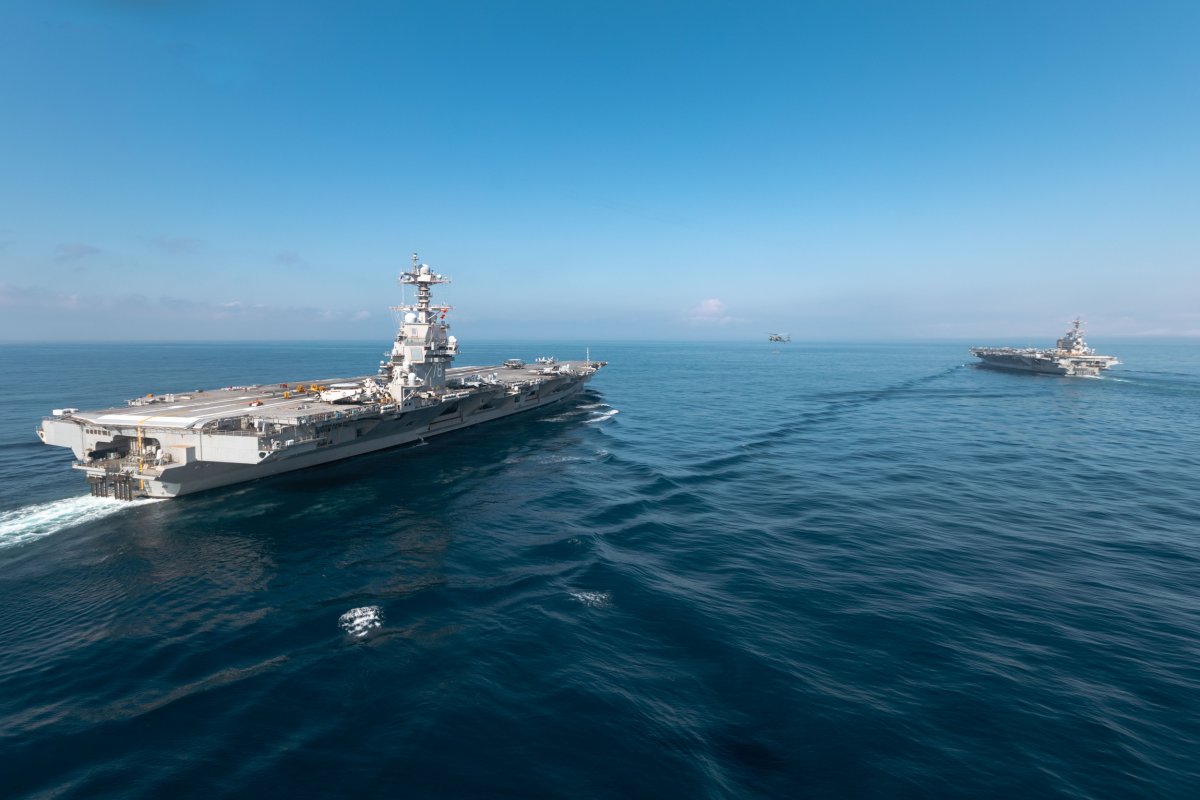The United States recently deployed two nuclear-powered aircraft carriers, USS Gerald R. Ford and USS George H.W. Bush, in the Atlantic following a similar operation by China in the Pacific as both countries compete for naval dominance across the world.
Why It Matters
While the U.S. Navy possesses the largest fleet of aircraft carriers in the world—with 11 vessels in service—China operates more than 370 ships and submarines, including two aircraft carriers in active service, making it the world’s largest navy by hull count, according to the Pentagon.
Last month, the Chinese navy simultaneously deployed its aircraft carriers—CNS Liaoning and CNS Shandong—in the broader western Pacific. This came as one of the two American aircraft carriers operating in the region, USS Nimitz, was redeployed to the Middle East.
What To Know
According to a set of photos released by the U.S. Navy on Wednesday, the Gerald R. Ford and the George H.W. Bush were seen operating side by side on June 27 at an undisclosed location in the Atlantic, where they conducted resupply operations and ammunition transfers.

Mass Communication Specialist 2nd Class Maxwell Orlosky/U.S. Navy
The Gerald R. Ford departed Naval Station Norfolk, Virginia, on June 24 for a “regularly scheduled deployment” to the U.S. European Command, forming a strike group with five destroyers to support economic prosperity, national security and defense, the Navy said.
Photos taken by ship spotters show that the George H.W. Bush departed Naval Station Norfolk on June 10 and returned on Tuesday. While underway in the Atlantic, the aircraft carrier conducted “Tailored Ship’s Training Availability and Final Evaluation Problem,” the Navy said.
The training—referred to as TSTA/FEP—is designed to build crew operating proficiency and to enhance the ship’s ability to self-train, according to the Navy. It prepares the ship and crew for integration into a strike group through a wide range of mission-critical operations.
The Gerald R. Ford, commissioned in 2017 and becoming operational four years later, is the lead ship of the next generation of the U.S.’s aircraft carriers. The George H.W. Bush is one of 10 vessels in the older Nimitz-class, which entered service between 1975 and 2009.
As the successor to the Nimitz class, the Gerald R. Ford-class features design improvements, including the ability to launch more aircraft and generate more electrical power for shipboard systems. The Navy plans to procure six new aircraft carriers, including the lead ship itself.

Mass Communication Specialist 2nd Class Maxwell Orlosky/U.S. Navy
Meanwhile, China is testing its most advanced aircraft carrier, CNS Fujian, which features electromagnetic catapults for launching aircraft, similar to those on the Gerald R. Ford. The Pentagon previously assessed that the Fujian would be operational in the first half of 2025.
What People Are Saying
The U.S. Second Fleet announced on June 24: “The Gerald R. Ford Carrier Strike Group provides combatant commanders and America’s civilian leaders increased capacity to underpin American security and economic prosperity, deter adversaries, and project power on a global scale through sustained operations at sea.”
The U.S. Navy said in a fact sheet last updated on February 27: “Often the presence of an aircraft carrier has deterred potential adversaries from striking against U.S. interests. Aircraft carriers support and operate aircraft that engage in attacks on airborne, afloat and ashore targets that threaten free use of the sea and engage in sustained power projection operations in support of U.S. and coalition forces.”
What Happens Next
It remains to be seen whether the U.S. will deploy a second aircraft carrier to the western Pacific to reinforce its naval presence as China’s navy continues to expand its operations.
